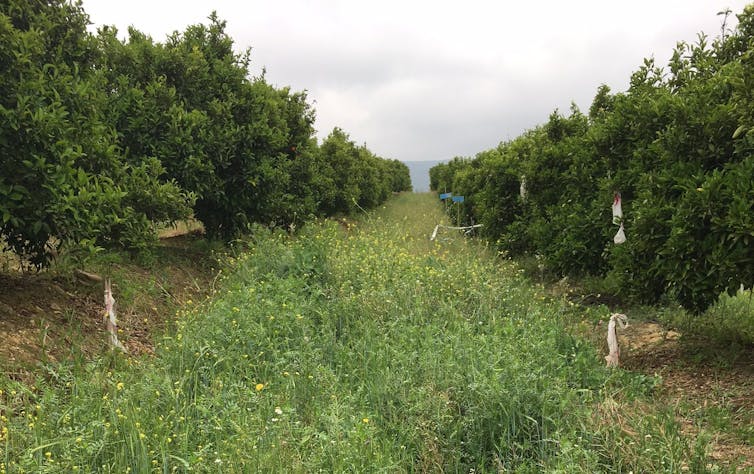Los desafíos invisibles de una agricultura verde en Europa
La pandemia nos ha enseñado que el medio ambiente tiene un papel fundamental en la salud mundial. La biodiversidad y el buen estado de los ecosistemas no solo son un seguro para la sostenibilidad y habitabilidad del planeta. Ambos protegen nuestra nuestra salud, poniendo barreras naturales a los virus. La agricultura es medio ambiente, forma agroecosistemas, y las prácticas sostenibles en agricultura sirven tanto a la salud de la población como a la del planeta.
Los agroecosistemas producen mucho más que alimentos. Cuando están bien mantenidos y en armonía con la naturaleza, sus diversas funciones sirven al bienestar humano, generan servicios ecosistémicos. Por ejemplo:
- filtran el agua en los suelos y fijan el propio suelo en su lugar,
- disminuyen inundaciones y coladas de barro,
- atraen polinizadores,
- retienen carbono en suelos y vegetación, que no se incorpora a la atmósfera disminuyendo los gases de efecto invernadero,
- y albergan paisajes que son herencias culturales de territorios, preservando su memoria colectiva.
La agricultura dentro del Pacto Verde europeo
El Pacto Verde europeo, que propone conseguir una Europa climáticamente neutra en 2050, y ser el primer continente climáticamente neutro, pone uno de sus focos en la agricultura. Pretende cambiar progresivamente la forma en que se practica hoy en día. Actualmente, es el segundo sector en emisiones de gases de efecto invernadero (11 %) de la Unión Europea (UE), por delante del sector industrial.
El sistema agroindustrial intensivo actual de producción de alimentos y consumo no es sostenible. Es, en gran parte, responsable de desastres ambientales como la degradación de suelos sobreexplotados y formas de paisaje artificiales que propician inundaciones. Flujos cargados de nutrientes que contaminan ríos, lagunas interiores, acuíferos subterráneos y el mar.
Para poder realizar esta transición hacia una agricultura más verde y sostenible, en un plazo de tiempo corto, se ha diseñado dentro del Pacto Verde la estrategia “De la granja a la mesa”. Se trata de una amplia declaración de intenciones que abarca todo el sistema alimentario, desde la producción de alimentos, a la distribución y el consumo.
Esta estrategia quiere respetar los límites del planeta tanto al producir como al consumir; alimentos sanos en un mundo sano. La agricultura es, asimismo, un elemento clave en otro gran pilar del Pacto Verde: la estrategia de Biodiversidad, que entiende que un planeta sano pasa por una agricultura sostenible.

La estrategia “De la granja a la mesa” propone alcanzar un mínimo de un 25 % de agricultura ecológica en territorio europeo, reducir un 50 % el uso de pesticidas y un 20 % el uso de fertilizantes, todo ello en menos de una década (2030). Estos cambios son un importante reto para nuestra sociedad.
Pero, dada la complejidad de los sistemas de producción y distribución de alimentos y sus efectos, nos preguntamos:
- ¿Un sistema agrícola más ecológico producirá suficientes alimentos para dar de comer a la creciente población mundial (8 600 millones en 2030)?
- ¿Producirá Europa alimentos con menos impacto en el medio ambiente a costa de externalizar parte de la producción y sus impactos negativos a otros países?
- ¿Son necesarios cambios en nuestra dieta para favorecer un sistema alimentario más sostenible?
Los desafíos de la estrategia europea
Una cosa parece clara: una transición viable hacia una agricultura más verde no puede basarse solo en la producción sostenible, sino también en el consumo responsable. Los cambios, frecuentemente, no son tan fáciles y directos. Bajo la estrategia “De la granja a la mesa” subyacen una serie de desafíos invisibles:
¿La producción será suficiente?
No existe consenso científico sobre si un aumento importante de la producción en ecológico podrá alimentar a la población mundial. Según la cumbre de la FAO de 2008 en Roma sobre Seguridad Alimentaria Mundial, la producción de alimentos debe aumentar un 50 % para 2030, y duplicarse para 2050 para alimentar a 9 mil millones de personas en el planeta. Pero no toda la comunidad científica está completamente de acuerdo en estas previsiones.
En este contexto, la UE pretende convertir un mínimo del 25 % del terreno agrícola a agricultura ecológica, a pesar de que algunos estudios indicaron una disminución de la producción entre el 20 % y el 35 % en agricultura ecológica comparada con la agricultura convencional. La clave podría estar en combinar esta medida con otras.
¿Qué ocurre con las restricciones de fertilizantes?
La adición limitada de fertilizantes minerales en agricultura ecológica, como por ejemplo nitrógeno, provoca su búsqueda en otras fuentes alternativas, como la plantación de leguminosas. Para compensar este déficit de nitrógeno sintético, se debe utilizar más superficie para plantar leguminosas, que fijan biológicamente el nitrógeno, y sirve para suministrar nitrógeno a cultivos no leguminosos. Esto implica menor superficie disponible para otros cultivos. La fijación de nitrógeno por leguminosas propuesta por la agricultura ecológica necesitaría 2,6 unidades de tierra más para producir el mismo rendimiento que la agricultura convencional.

¿Cambiaremos nuestra dieta?
La agricultura ecológica combinada con una reducción de la ganadería es una solución prometedora para avanzar en sistemas alimentarios sostenibles. La reducción de la ganadería implicaría una reducción de la demanda de tierra para alimentar al ganado.
Esta solución pasa necesariamente por un cambio en la dieta, reduciendo el consumo de productos animales, con implicaciones positivas para el medio ambiente y la salud de la población. Aquí desempeñan un papel importante, de nuevo, las leguminosas. Además de fijar nitrógeno en el suelo, necesario para los cultivos, el consumo de legumbres como fuente de proteínas compensaría el descenso del consumo de proteínas de origen animal.
¿Reduciremos el desperdicio alimentario?
Junto con la reducción de la ganadería y el aumento de la agricultura ecológica, la reducción del desperdicio alimentario es clave. Hay varias causas de desperdicio de alimentos: problemas de procesamiento y falta de planificación adecuada, pérdidas tras las cosechas para control de precios, y el desperdicio que hacemos en nuestras propias casas. Por ejemplo, un consumidor estadounidense medio desperdicia una cuarta parte de la comida diaria disponible para el consumo y un 7 % de la tierra de cultivo anual.
De aproximadamente un tercio de los alimentos producidos a nivel mundial que no se consumen, alrededor de un 14 % corresponde a pérdidas tras las cosechas. Esta es una práctica principalmente utilizada en países relativamente ricos para controlar los precios de mercado, evitando que los precios bajen por debajo de los costes de producción. Tiene un elevado impacto ambiental, y además consume recursos naturales que finalmente no aportan alimentos al mercado.
¿Externalizaremos los impactos negativos?
El riesgo de externalizar el daño de la agricultura intensiva a otros países que no ponen limitaciones al uso de pesticidas, herbicidas, fertilizantes y deforestación para uso agrícola, pero suministran alimentos a la UE, es uno de los peligros de esta estrategia. La misma estrategia reconoce que el sistema alimentario de la UE debe acompañarse de políticas similares a nivel mundial, para evitar que Europa importe alimentos producidos en otros países en condiciones no sostenibles.
Respetar la naturaleza y los derechos sociales
La estrategia deja abiertas diferentes vías para la consecución de sus objetivos, sin concretar de momento más allá. Prevé utilizar algunos instrumentos legales, entre ellos:
- El Fondo Europeo Agrario de Desarrollo Rural (FEADER).
- Diferentes directivas y planes de acción (Plan de Acción para la Economía Circular, Gestión Integrada de Plagas, etc.).
- La Política Agraria Común (PAC) adaptada a cada estado miembro.
La estrategia da especial importancia a los derechos sociales, con foco en los trabajadores precarios, estacionales y no declarados, mano de obra demasiado frecuente en la agricultura intensiva. Y apoya el impulso de diferentes estrategias de manejo agrícola sostenible. Actualmente, conviven, y se solapan, variadas prácticas agrícolas verdes. Buscan compatibilizar la producción de alimentos, modos de vida sostenible y dignos con:
- el respeto medioambiental (agricultura ecológica),
- la lucha contra el cambio climático (agricultura del carbono),
- el control de la degradación del suelo (agricultura de conservación),
- el aumento de la biodiversidad (diversificación del cultivos, agricultura ecosistémica),
- todas estas prácticas buscan en general la mejora de variados servicios ecosistémicos.

Algunas de estas prácticas pueden ser similares, aunque con diferentes matices. Distintos sistemas agrícolas, con enfoques desde más intensivos a más extensivos. Algunos poniendo el acento en la productividad, optimizando recursos (agricultura de precisión, vertical) hasta los que tienen como finalidad dejar una herencia medioambiental y cultural limpia y en buenas condiciones a futuras generaciones (agricultura regenerativa).
Generalizando, podemos agruparlos en dos grandes modelos. Ambos coinciden en algunos aspectos y discrepan en otros:
- La intensificación sostenible. Se centra en optimizar la agricultura a gran escala mientras se reducen sus impactos medioambientales negativos. Su lema podría resumirse en “alimenta al mundo de forma sostenible”.
- La agroecología. Aplica principios ecológicos y de sostenibilidad a todo el sistema alimentario, poniendo el foco en promover los procesos naturales del ecosistema para producir alimentos, basándose en el conocimiento tradicional y local. Busca la justicia social y la soberanía alimentaria, empoderando a los productores. Su lema podría resumirse en “ayuda al mundo a alimentarse de forma sostenible”.
La polémica y los conflictos entre enfoques están servidos, desde los que acusan al primer modelo de seguir sometido al sistema neoliberal y realizar green washing hasta los que acusan al segundo de ser poco realista y no poder aplicarse a gran escala.
El foco en la agricultura del Pacto Verde es enormemente ambicioso, pero necesario. Nos saca de la inacción. Es probablemente mejorable, pero puede significar un cambio en la concepción de los sistemas alimentarios y en la utilización de la naturaleza al servicio de la humanidad. Aprovechemos esta oportunidad, busquemos la equidad y trabajemos con la naturaleza, no contra ella.

